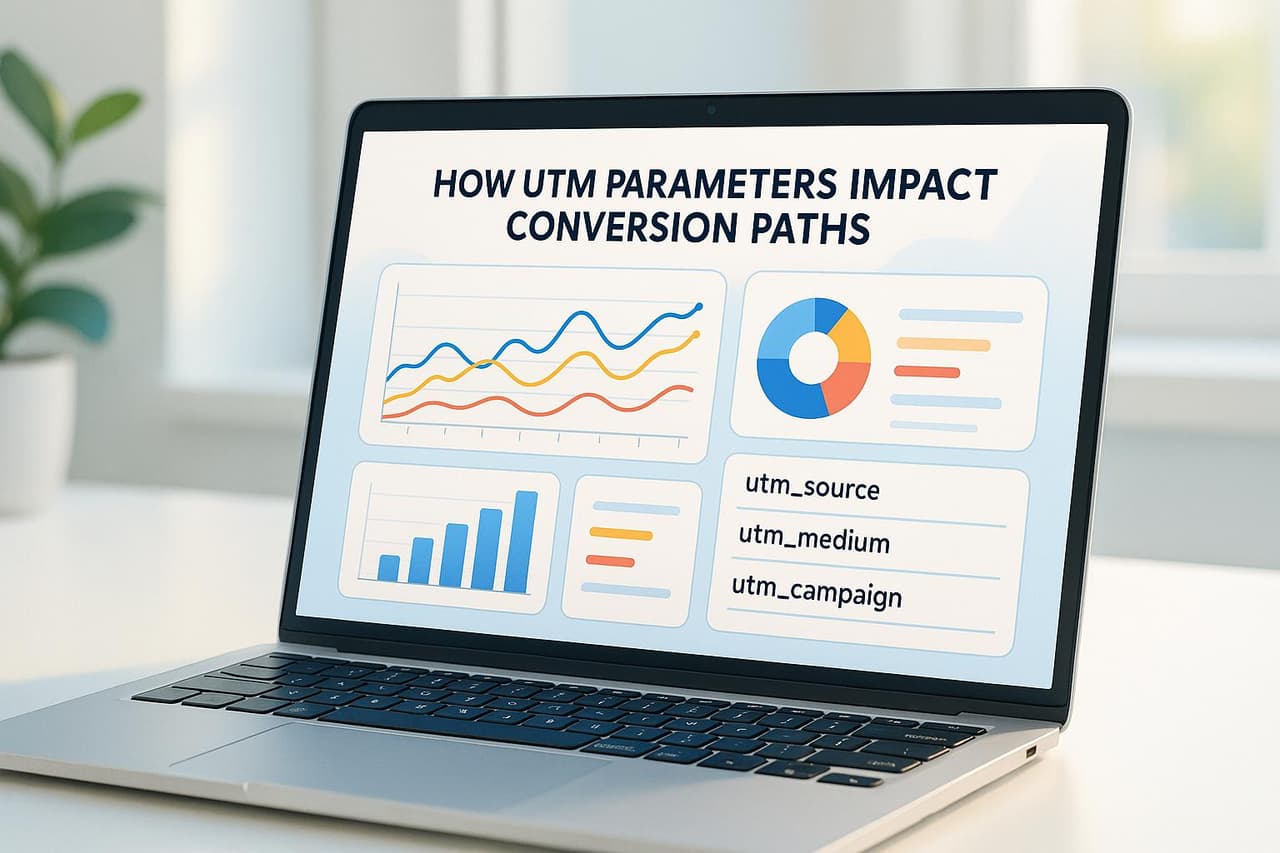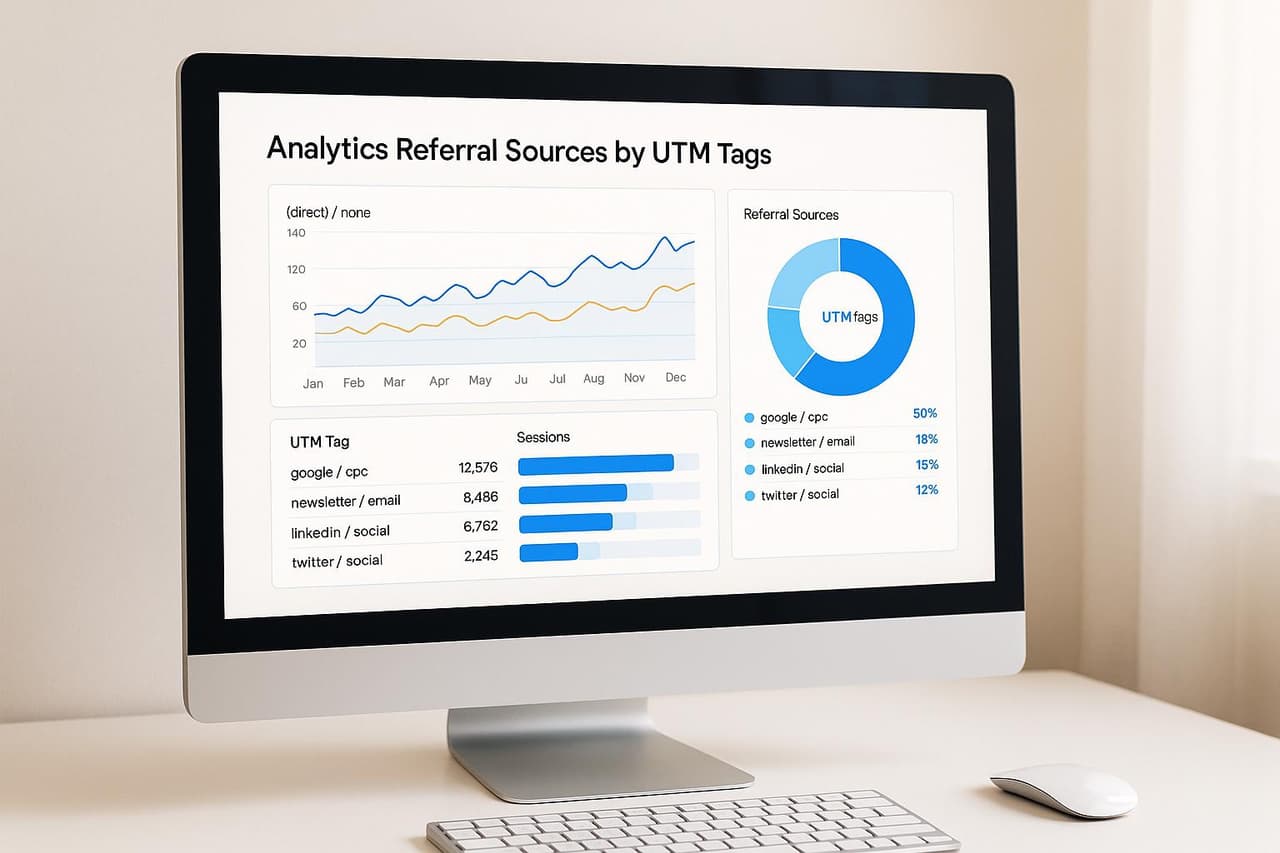
Want to improve your marketing results? Start by mastering these tools: UTMs, tracking, attribution, conversions, and deep links. They help you track campaigns, understand customer behavior, and boost ROI. Here’s a quick breakdown:
- UTMs: Add parameters to URLs to track traffic sources (e.g., email, social).
- Tracking: Analyze user behavior across devices and channels.
- Attribution: Identify which marketing efforts drive conversions.
- Conversions: Measure actions like purchases, sign-ups, or downloads.
- Deep Links: Direct users to specific in-app or web content for smoother navigation.
For example, businesses using data-driven strategies see up to an 8x ROI, and tools like deep links can increase app conversion rates by 66%. This guide explains how these tools work, common mistakes to avoid, and tips to get started.
UTM Parameters: Core Campaign Tracking Tools
UTM Parameters Explained
UTM (Urchin Tracking Module) parameters are tracking codes added to URLs to help marketers assess the performance of campaigns across various channels. They consist of five main components that work together to provide detailed insights into traffic sources and user behavior.
UTM Setup Guidelines
Once you understand the components of UTM parameters, setting them up correctly becomes essential for reliable tracking. Research shows that 81% of shoppers research online before making significant purchases [3].
Here’s how to set up UTM parameters effectively:
- Stick to lowercase: Since UTM parameters are case-sensitive, "Facebook" and "facebook" will appear as separate sources in your reports [5]. Using lowercase for all values ensures consistency.
- Standardize naming conventions: Maintain a master spreadsheet to document your UTM structure. This approach keeps your team aligned and prevents confusion.
- Be descriptive: Instead of generic labels like "ad1", opt for specific names such as "summer_promo_video" to make your data easier to interpret.
For example, Redfin’s email marketing campaigns use clear UTM structuring:
utm_campaign=instant_listings_update&utm_medium=email&utm_source=myredfin [4]
Fixing Common UTM Errors
Matt Moore, Associate Manager of Product Marketing at impact.com, highlights the importance of consistency:
"UTM parameters are case sensitive. 'Facebook' and 'facebook' will appear in your reports as two different sources. Use lowercase for all your values to help avoid running into trouble with inconsistent capitalization." [5]
Here are some common UTM mistakes and how to address them:
- Duplicate Parameters: If a URL contains duplicate parameters, such as
example.com/?utm_source=facebook&utm_medium=social&utm_source=instagram
only the last source (instagram) will be recorded in GA4 [6].
- Formatting Issues: Missing ampersands between parameters can disrupt tracking. The correct format is:
example.com/?utm_source=google&utm_medium=cpc&utm_campaign=spring_sale
- Internal Link Tracking: Avoid using UTMs for internal navigation, as this can break session tracking and distort your data [5].
Platforms like PIMMS offer real-time analytics and tools to catch these errors, ensuring consistent UTM formatting and naming. By addressing these common pitfalls, marketers can maintain accurate tracking and make better-informed decisions.
UTM Parameter Tracking Fundamentals and Best Practices
Campaign Data Collection Methods
Once you've got a handle on UTMs, the next step is understanding how data is gathered. This knowledge is crucial for interpreting campaign performance and making informed decisions. Let’s break down the key methods and best practices for collecting actionable campaign data.
Click vs. Impression Tracking
Two key metrics often define campaign performance: impressions (how visible your brand is) and clicks (how engaged users are). Here's a quick comparison:
"Impressions count how often your site appears in Google search results - think of it as eyes passing by. Clicks, though, track when someone actually visits your site. They're different metrics: impressions show visibility, while clicks measure action." [7]
While impressions reflect how many people saw your ad, clicks measure how many took action. Together, they offer a fuller picture of campaign performance. To dig even deeper, tracking user sessions can provide additional insights into engagement.
User and Session Tracking
Tracking users and their sessions allows for a closer look at behavior, helping you understand how people interact with your campaigns. This is especially important because 76% of consumers say they avoid buying from organizations they find untrustworthy [8].
Key areas to monitor include:
- Session duration: How long users stay engaged with your content.
- Cross-device journeys: Following users as they switch between devices.
- Bounce rates: Measuring how often users leave without interacting.
By focusing on these metrics, you can fine-tune your campaigns to better meet user expectations. At the same time, it's important to prioritize privacy and data security.
Privacy-First Tracking Methods
In today’s digital landscape, respecting user privacy isn’t optional - it’s essential. Companies that invest in privacy-first practices often see a $160 return for every $100 spent [9].
"Don't collect data because it 'might' be useful someday – that mindset leads to troves of unused, risky data. And for the data you do have, double down on security. That means encrypting data whether it's stored or being sent, limiting access to only the people who need it, and being smart about how you handle it." – Nate Gouldsbrough, Intellibright [9]
To prioritize privacy, consider these best practices:
- Use consent management tools to ensure users agree to data collection.
- Opt for privacy-preserving analytics that anonymize personal information.
- Encrypt data both during storage and transmission.
- Limit data collection to only what’s absolutely necessary.
- Offer clear opt-out mechanisms to give users control.
Additionally, collecting first-party data in compliance with regulations like GDPR and CCPA not only ensures legal compliance but also builds trust. In fact, 81% of consumers view how organizations handle their data as a reflection of how much they value their customers [8]. By adopting privacy-first methods, you not only protect user data but also strengthen your brand's reputation.
It starts here
If you made it this far, it's time to grab 10 free links.
10 smart links included • No credit card
Measuring Marketing Impact Through Attribution
Attribution helps identify which marketing touchpoints lead to conversions, enabling better campaign planning and budget allocation. Let’s break down the key components and strategies for measuring marketing impact.
Types of Attribution Models
Attribution models assign credit to different touchpoints in a customer’s journey, offering insights into what drives results. Each model serves a specific purpose:
Interestingly, only 11% of marketers currently use algorithmic attribution models, despite their ability to provide deeper insights [11]. Yet, companies that adopt attribution models often see up to a 30% boost in marketing efficiency [10]. Choosing the right model depends on understanding your customer journey and business goals.
Conversion Types and Metrics
Tracking both macro and micro conversions gives a well-rounded picture of performance. Here are some key metrics to monitor:
- Primary Conversions: Major actions like sales, subscriptions, or form completions.
- Secondary Actions: Smaller but valuable steps, such as email sign-ups, content downloads, or account creations.
- Engagement Indicators: Metrics like time spent on site, page views, or repeat visits.
For example, Clean Origin analyzed their customer interactions across YouTube and website visits. They found Instagram to be a standout channel for engagement, with over 51,000 followers compared to fewer than 200 on X [12]. This insight allowed them to focus their efforts where it mattered most.
Sales Attribution Methods
Once you’ve identified conversion metrics, tying revenue to specific marketing efforts becomes the next challenge. Take Rogers Communications, for instance. By leveraging AI-driven attribution, they reduced their cost per acquisition by an impressive 82% over two years [13].
To improve sales attribution, consider these steps:
- Unify Data: Link CRM tools with marketing platforms for a complete customer view.
- Standardize Tracking: Use consistent UTM parameters across all campaigns.
- Capture Cross-Device Journeys: Ensure tracking spans multiple devices to follow the entire customer path.
- Refine Regularly: Continuously review performance data to adjust strategies.
Despite the benefits, 21% of marketers still rely on single-channel attribution models [11], which can overlook the complexity of multi-channel interactions. To get the most out of your efforts, explore multi-touch attribution, which accounts for every customer interaction across different platforms and touchpoints. This approach ensures no valuable insight is left behind.
Deep Linking Fundamentals
Deep links are URLs designed to take users directly to specific in-app or web content, bypassing general entry points like a homepage. By integrating precise tracking and attribution, deep linking smooths out the user journey, reducing unnecessary steps and improving overall navigation.
Deep Link Types and Functions
Deep linking operates through three main types, each tailored to specific user needs:
Campaigns using deep links can achieve up to 6x higher conversion rates compared to standard links [17]. These three types work together to address gaps in user journeys, especially when users don’t already have the app installed. That’s where deferred deep linking stands out.
Deferred Deep Link Tracking
Deferred deep linking solves a common mobile marketing problem: how to ensure users land on the right content even if they need to install the app first. By preserving the target destination throughout the installation process, deferred deep links deliver measurable results:
- 37% higher 30-day retention
- 2.8x faster first in-app actions
- 43% higher reinstallation rates [18]
Here’s an example: MakeMyTrip introduced a deep-linked web-to-app smart banner system. The results? A 15% increase in one-day retention, a 13% boost in one-week retention, and a 12% growth in one-month retention rates [14].
Deep Link Implementation Guide
To make the most of deep linking, follow these steps:
- Strategic Planning
Identify critical conversion points in the user journey where deep links can reduce friction and streamline actions. - Technical Integration
Use cross-platform URL schemes like Universal Links for iOS and App Links for Android. Test thoroughly to ensure seamless redirection. - Performance Optimization
Regularly monitor and analyze deep link performance. Mobile app users often convert at rates up to 3x higher than those on mobile websites [14].
"Deep linking improves engagement, boosts brand awareness, and drives key KPIs such as conversion and retention rates."
- Alix Carman, Content Writer, Adjust [15]
When implemented effectively, deep links can increase app conversion rates by an average of 66%, creating smoother and more personalized paths to the content users want [16].
Conclusion
This guide has broken down key tracking terms and tools, emphasizing the importance of UTMs, attribution, conversions, and deep links in boosting digital marketing outcomes. These elements are essential for improving campaign performance and increasing ROI.
The impact of these strategies is evident. For example, a B2B SaaS company found that their LinkedIn posts generated 40% more high-value sign-ups compared to paid ads after adopting link-based attribution [19]. Similarly, Product Hunt's use of tracking revealed that their TikTok bio link was driving hundreds of daily clicks, leading to a 200% surge in newsletter signups [19].
This success highlights the importance of precise and consistent tracking across all marketing channels.
To replicate these results, focus on the following practices:
- Use standardized UTM naming conventions.
- Apply effective deep linking strategies.
- Regularly monitor and analyze tracking data.
- Integrate tracking with analytics platforms.
- Prioritize privacy-compliant tracking methods.
"Only accurate or consistent UTM tagging can result in reliable marketing attribution reports, undermining the effectiveness of your marketing efforts" [1].
"Clean marketing attribution is key to making informed marketing decisions that optimize budget allocation and enhance overall ad effectiveness" [2].
Tracking isn’t just about gathering data – it’s about turning that data into actionable insights that deliver measurable results.
FAQs
How can I set up UTM parameters correctly to avoid tracking mistakes?
To set up UTM parameters correctly and avoid common tracking errors, keep these tips in mind:
- Stick to consistent naming rules: Use lowercase letters, and steer clear of spaces or special characters. This keeps your data clean and easier to interpret.
- Create a standardized UTM guide: Develop a shared document for your team that outlines how to format parameters like
source,medium, andcampaign. Consistency across campaigns is key. - Always test your links: Before going live, verify that your UTM links point to the correct URLs and are being tracked properly by your analytics tools. Testing helps catch mistakes early.
These steps will help minimize mistakes and ensure your tracking data is reliable for making informed decisions.
What’s the difference between standard, deferred, and contextual deep links, and how can marketers use them effectively?
Deep links are a powerful tool for directing users to specific content within an app, and they come in a few different flavors, each serving a unique purpose:
- Standard deep links: These links take users straight to specific content within an app - provided the app is already installed. For example, tapping a link in an ad might open a product page directly in the app, making the user journey smoother and increasing the chances of conversion.
- Deferred deep links: These step things up by working even if the app isn’t installed. When users click a deferred deep link, they’re prompted to download the app. Once installed, the link takes them directly to the intended content. This approach is especially effective for re-engaging users and encouraging app downloads.
- Contextual deep links: These links offer a more personalized experience by factoring in user data, such as referral sources or device type. By delivering content tailored to individual preferences, marketers can boost engagement and retention.
When used thoughtfully, these deep link types can enhance user acquisition, simplify onboarding, and deliver stronger results for campaigns.
Why does choosing the right attribution model matter for my marketing strategy, and how can it impact my campaign's performance?
Selecting the right attribution model plays a critical role in how you evaluate the performance of your marketing efforts and assign credit to different points along the customer journey. The model you choose directly influences your understanding of which channels and interactions are driving conversions, helping you make smarter decisions about where to invest your time and budget.
Take, for instance, the first-touch attribution model. This approach emphasizes the very first interaction a customer has with your brand, giving you insight into how people initially discover you. On the other hand, a multi-touch attribution model paints a broader picture, showing the impact of various touchpoints throughout the entire journey and identifying which steps were the most influential.
Picking the wrong model can throw your strategy off course, leading to wasted resources and missed opportunities. But when you select the right one, you’ll have a clearer view of what’s working, ensuring your campaigns deliver stronger results and a better return on investment.



